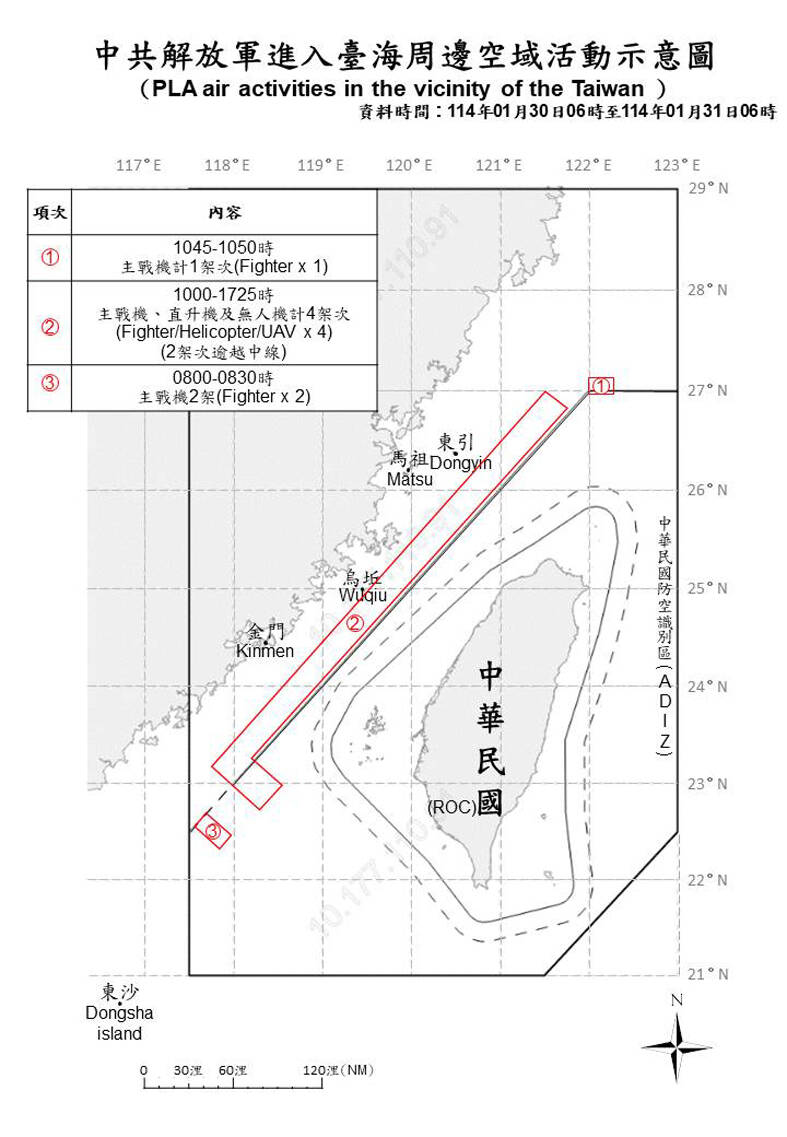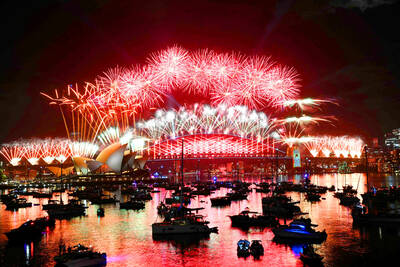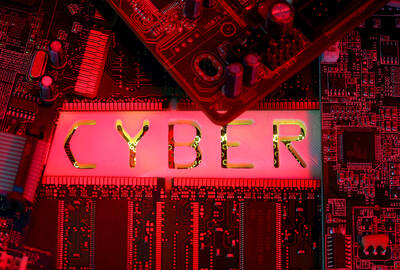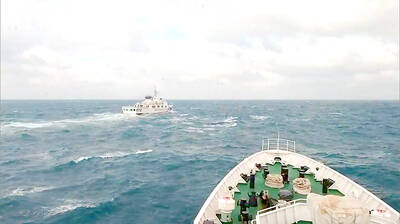The first tranche of the US Navy’s “Replicator” initiative aimed at obstructing a Chinese invasion of Taiwan would be ready by August, a US Naval Institute (USNI) News report on Tuesday said.
The initiative is part of a larger defense strategy for Taiwan, and would involve launching thousands of uncrewed submarines, surface vessels and aerial vehicles around Taiwan to buy the nation and its partners time to assemble a response.
The plan was first made public by the Washington Post in June last year, when it cited comments by US Indo-Pacific Commander Admiral Samuel Paparo on the sidelines of the Shangri-La Dialogue defense forum in Singapore.

Photo courtesy of the Ministry of National Defense
USNI News cited Captain Alex Campbell, the maritime portfolio director of the US Department of Defense’s Defense Innovation Unit, as saying that the initiative involves integrating various systems in a fast-paced manner through the use of common software.
His team is trying to stitch together “a pretty wide and diverse set of systems and a wide and diverse set of software, and smashing them all together at a pace that is really more akin to commercial software tempos,” Campbell said.
The report also cited US Pacific Fleet Commander Admiral Steve Koehler as saying he wanted “more lethal and inexpensive systems” available for the initiative, and that he wanted them “in the hands of sailors to experiment with and field quickly.”

Photo: AP
Replicator, for which the US Navy has budgeted US$1 billion, would make use of uncrewed systems in every domain, including one-way attack drones and loitering munitions.
The overall strategy would also involve intelligence gathering, and the use of infrastructure to support a GPS and intelligence denied environment, a previous report by Naval News said.
Connected by satellites, high-altitude long-endurance uncrewed aerial vehicles and other networked systems would engage large amphibious fleets crossing the Taiwan Strait from multiple vectors, with the US drones coming from islands, undersea and from drone motherships far outside the first island chain, that report said.
The Replicator program has prompted the US military to rethink the use of autonomous combat systems, and emphasize learning and rapid adjustments to meet future battlefield needs, US Navy Director of Integrated Warfare Rear Admiral Christopher Sweeney said.
Chris Brose, strategic director of defense contractor Anduril Industries, said that with Replicator, the navy also aims to “quickly field disparate systems,” and to adopt a more flexible development approach to ensure that the technology could be quickly put into actual combat applications in the Taiwan Strait.
Koehler said the US military should deploy more “low-cost and high-lethality” uncrewed systems, and that troops should conduct combat tests and exercises with such systems in the Strait.
In related news, the Ministry of National Defense yesterday reported that seven Chinese military aircraft were detected in the Taiwan Strait in the 24-hour period from 6am on Thursday to 6am yesterday, five of which crossed the median line of the Strait, moving toward areas to the north and southwest of Taiwan’s airspace.
Five Chinese warships were also detected operating around the Strait during this period, it said.
In the previous 24-hour period from 6am on Wednesday to 6am on Thursday, in addition to the five Chinese warships, six military planes were detected in the vicinity, three of which crossed the median line and flew toward areas near the northern and southwestern parts of Taiwan’s airspace, ministry data showed.
Three Chinese weather balloons were also detected over waters northwest of Taichung late on Wednesday afternoon, it said.
The ministry said it monitored the movements of the Chinese military and balloons using aircraft, ships and shore-based missile systems, and was ready to respond at all times.
Additional reporting by Huang Ching-yan

Auckland rang in 2026 with a downtown fireworks display launched from New Zealand’s tallest structure, Sky Tower, making it the first major city to greet the new year at a celebration dampened by rain, while crowds in Taipei braved the elements to watch Taipei 101’s display. South Pacific countries are the first to bid farewell to 2025. Clocks struck midnight in Auckland, with a population of 1.7 million, 18 hours before the famous ball was to drop in New York’s Times Square. The five-minute display involved 3,500 fireworks launched from the 240m Sky Tower. Smaller community events were canceled across New Zealand’s

The Ministry of Foreign Affairs (MOFA) yesterday said it is closely monitoring developments in Venezuela, and would continue to cooperate with democratic allies and work together for regional and global security, stability, and prosperity. The remarks came after the US on Saturday launched a series of airstrikes in Venezuela and kidnapped Venezuelan President Nicolas Maduro, who was later flown to New York along with his wife. The pair face US charges related to drug trafficking and alleged cooperation with gangs designated as terrorist organizations. Maduro has denied the allegations. The ministry said that it is closely monitoring the political and economic situation

UNRELENTING: China attempted cyberattacks on Taiwan’s critical infrastructure 2.63 million times per day last year, up from 1.23 million in 2023, the NSB said China’s cyberarmy has long engaged in cyberattacks against Taiwan’s critical infrastructure, employing diverse and evolving tactics, the National Security Bureau (NSB) said yesterday, adding that cyberattacks on critical energy infrastructure last year increased 10-fold compared with the previous year. The NSB yesterday released a report titled Analysis on China’s Cyber Threats to Taiwan’s Critical Infrastructure in 2025, outlining the number of cyberattacks, major tactics and hacker groups. Taiwan’s national intelligence community identified a large number of cybersecurity incidents last year, the bureau said in a statement. China’s cyberarmy last year launched an average of 2.63 million intrusion attempts per day targeting Taiwan’s critical

‘SLICING METHOD’: In the event of a blockade, the China Coast Guard would intercept Taiwanese ships while its navy would seek to deter foreign intervention China’s military drills around Taiwan this week signaled potential strategies to cut the nation off from energy supplies and foreign military assistance, a US think tank report said. The Chinese People’s Liberation Army (PLA) conducted what it called “Justice Mission 2025” exercises from Monday to Tuesday in five maritime zones and airspace around Taiwan, calling them a warning to “Taiwanese independence” forces. In a report released on Wednesday, the Institute for the Study of War said the exercises effectively simulated blocking shipping routes to major port cities, including Kaohsiung, Keelung and Hualien. Taiwan would be highly vulnerable under such a blockade, because it